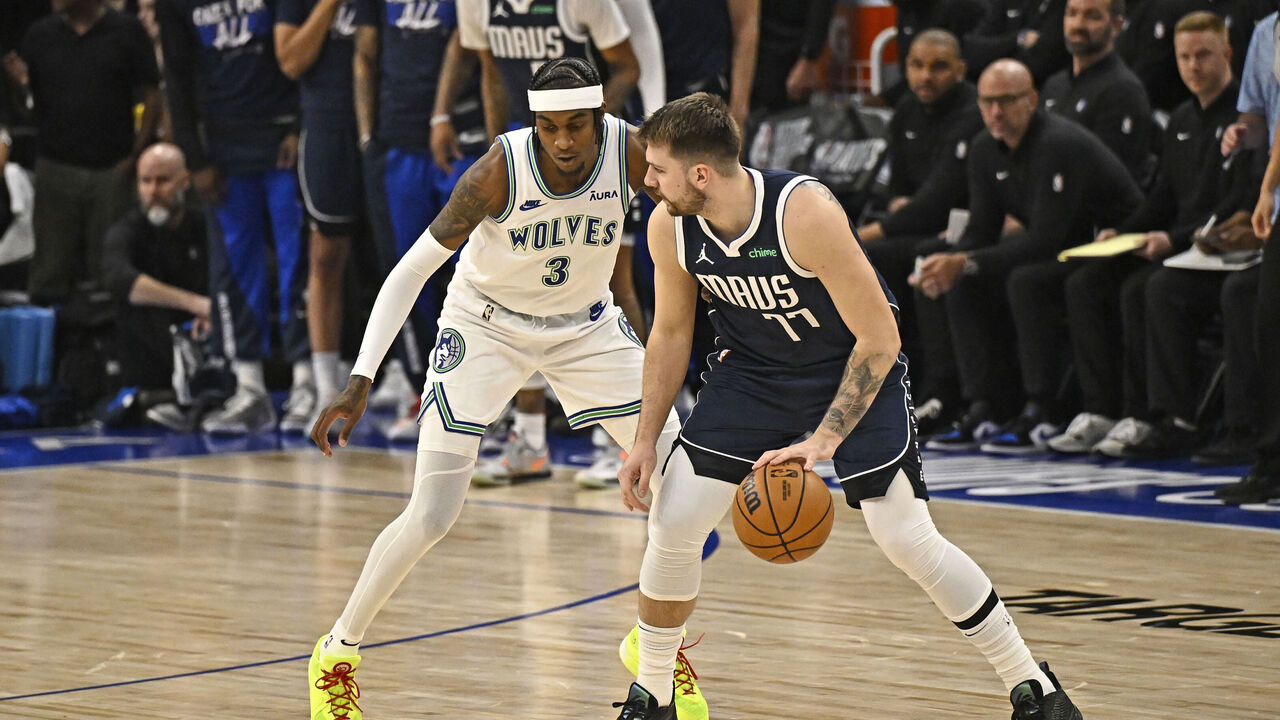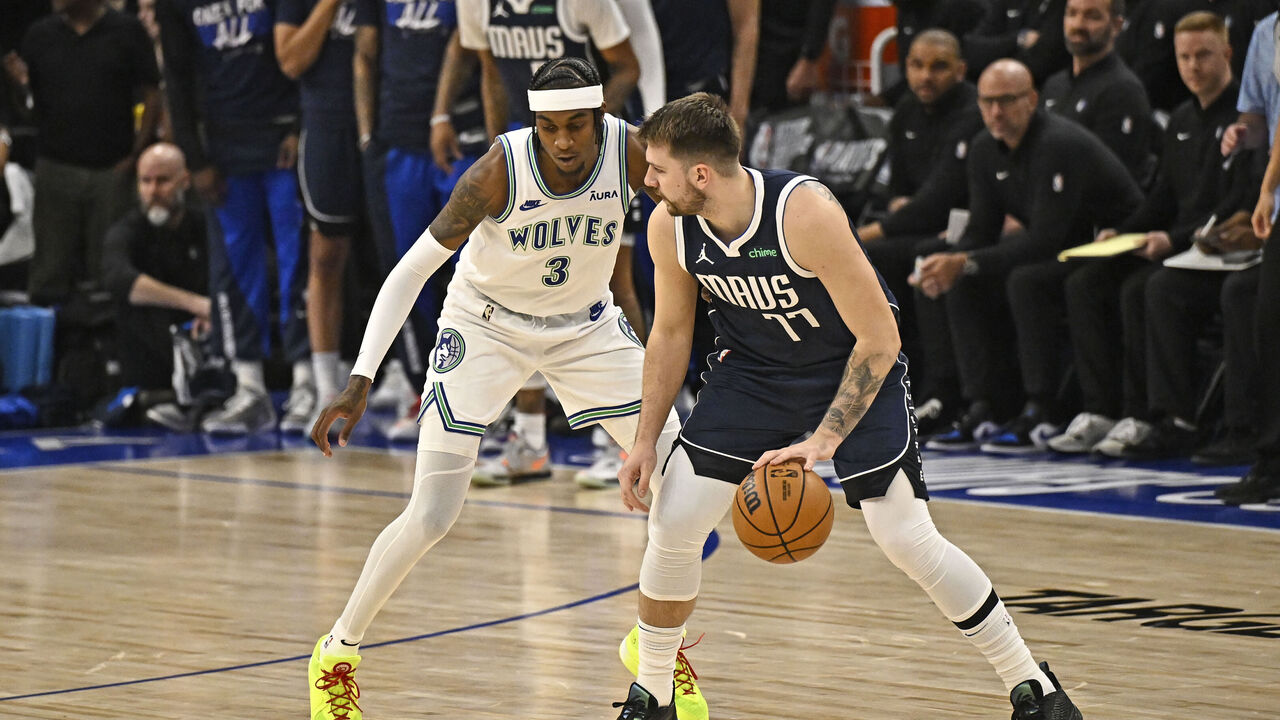Mavs again showcased their adaptability in Game 1 win over Wolves
In remaking their team around Luka Doncic over the last 16-odd months, the most important thing the Dallas Mavericks did was give themselves a lot more ways to win.
Acquiring Kyrie Irving jolted them into playing faster, made them less reliant on Doncic to create everything for everyone, and helped keep Doncic fresher for the end of games. By adding two athletic rim-running centers – first by drafting Dereck Lively II, later by trading for Daniel Gafford – they dramatically improved their interior defense while also becoming less dependent on jump shooting at the offensive end. Beefing up on the wing by signing Derrick Jones Jr. and trading for P.J. Washington gave them an influx of one-on-one options for opposing guards and forwards, along with a much-needed dose of secondary rim-protection.
All of that was on display in the Mavs’ Game 1 road win over the Minnesota Timberwolves in the Western Conference finals, as it’s been throughout their impressive playoff run. You couldn’t ask for a better showcase of their newfound adaptability than seeing them win that series opener while shooting 6-for-25 from 3-point range, and doing it after overcoming an Oklahoma City Thunder team that could hardly be more different than Minnesota in its roster construction and play style.
After working around a Thunder defense that spent six games overloading the strong side – showing Doncic and Irving a ton of extra bodies, tagging aggressively from the corners, and daring role players to beat them from outside – the Mavs ran up against a Wolves team that was determined to defend pick-and-rolls two-on-two, stay out of rotation, and take away corner threes.
To that end, Minnesota succeeded: After attempting 16.2 corner threes and 25 catch-and-shoot triples per game against OKC, Dallas got up only four corner threes and just 12 threes off the catch in Game 1. But that defensive tactic came with a cost for the Wolves. After being held in check as scorers in the second round, Doncic and Irving combined for 63 points while shooting 58% from 2-point range. Lively and Gafford also saw less traffic around the basket, and the Mavs as a team scored 62 paint points and shot 78% at the rim against Minnesota’s vaunted interior defense after struggling badly to score on the Thunder inside.
The Wolves primarily had Jaden McDaniels guarding Doncic, chasing him over screens and working to get back in front or contest from behind while Rudy Gobert dropped back and protected against the lob. They would occasionally stunt at Doncic from the wing or bring a back-side double when he posted up, but for the most part they avoided committing the kind of middle-of-the-floor help Doncic saw from the Thunder.

Irving was met with drop coverage less frequently than Doncic was, but saw similarly little help at the second level of defense when he was able to turn the corner or when he attacked off the catch. Which, along with some blazing transition forays and an uncharacteristically sluggish defensive showing from Anthony Edwards, allowed him to pop off for 24 first-half points that kept Dallas in the game while Doncic felt things out. Then Irving ceded control to his co-star down the stretch, and Doncic proceeded to carry the Mavs home with 15 fourth-quarter points on an array of unguardable leaners and step-backs.
It’s also worth noting that the Wolves did vary their coverages. Karl-Anthony Towns played up to the level against both Doncic and Irving for most of the game, which worked out well for the defense because Towns’ man (Washington) popped every single time instead of rolling, and shot 0-for-6 on above-the-break threes. Gobert varied the depth of his drop and mixed in some hard shows in the second half.
Mike Conley said afterward that Minnesota’s game plan was actually to have its screen defenders playing up high to limit Doncic and Irving while scrambling to close gaps on the back side. That obviously isn’t what wound up happening on the whole, though it worked to great effect at points – including on a crucial fourth-quarter possession when Gobert blitzed Doncic and Conley pulled over from the weak side to force a rolling Lively into a travel.
Mixing up schemes to keep the Mavs’ offense off-balance is always a good idea, but thinking that throwing a bunch of blitzes at them is going to be some kind of panacea would be incredibly wrongheaded. Dallas has seen that coverage a ton and has become expert at exploiting it. Doncic and Irving are such skilled creators that they can problem-solve their way around any scheme. If one of them gets blitzed, that often means the other one is available as a release valve to play four-on-three. It also often means the Wolves having to navigate those shorthanded back-side rotations with their two best and longest defenders (McDaniels and Gobert) out of the picture.
Doncic can also just shift to attacking without a screen, as he did in closing time of Game 1, and merely cook one of the best defenders on the planet in isolation.
Minnesota is definitely capable of tightening things up defensively, but that’s less about overhauling its scheme than it is about simply improving the execution and getting better individual play from guys like Edwards and Naz Reid, the latter of whom might’ve had his worst defensive performance of the postseason. The Wolves were still a plus-10 in Gobert’s minutes, indicating the way he was deployed wasn’t really their issue. They got smoked at the rim and on their own glass with him on the bench, with Irving and Lively in particular doing a number on the Towns-Reid frontcourt.
At the end of the day, Minnesota still held the Mavs to a 113.7 offensive rating, which is four points per 100 possessions lower than their regular-season average and only slightly better than they produced in their defensive slugfest against OKC. You can argue the Thunder could’ve afforded to defend a bit more like the Wolves at points in that series, or that the Wolves should try to defend a bit more like the Thunder in this one, but ultimately the Mavs’ offense is going to find its way to a bunch of points. In order to retake control of this series, Minnesota is going to have to figure out how to score more efficiently on this imposing Dallas defense.
On one hand, it doesn’t bode well for the Wolves that they couldn’t win Game 1 despite hitting 18 threes – including a 6-for-9 showing from McDaniels – and getting 11 points from Kyle Anderson off the bench. On the other hand, it feels mildly encouraging that they only lost by three points on a night their three most important offensive players (Edwards, Towns, and Conley) combined to shoot 14-for-43 from the field. They’ll have to hope that improvement on the latter front can outweigh any regression on the former, which is very possible but not a given, because the Mavs showed they have the means to make those guys’ lives difficult in a way the Suns and Nuggets couldn’t.
With Jones guarding Edwards and Washington guarding Towns, Dallas was able to comfortably switch screening actions involving those two. The Wolves pivoted to running more Edwards-Gobert pick-and-rolls, but Edwards still doesn’t fully trust Gobert on the roll and the Mavs did a good job putting taggers between him and the basket. (They also showed a willingness to switch Lively out onto the perimeter, though Gobert did a good job sealing smaller defenders and drawing free throws on the back side of those switches.)
Edwards rarely saw blitzes at the point of the screen, but any time he had the ball up top or threatened to touch the paint, Dallas loaded help behind his on-ball defender to muddy up his driving lanes and challenge his still-developing passing chops. He looked hesitant to drive and finished with just one made field goal inside the arc. The Wolves as a team shot only 56% at the rim, including 2-for-8 when one of Lively or Gafford was nearby.
Things got even more crowded when Anderson was on the floor, because despite his unexpected scoring contributions, Slo-Mo still had Minnesota playing four-on-five on offense a lot of the time. Watch how Irving “guarded” him on this possession, and how that allowed the Mavs to survive the Lively-on-Edwards matchup following a switch:
What was succesful against SGA, will likely also work against Ant.
The Mavericks switch the high pick and roll with Lively, and immediately triple switch it. They then load up, and dare Ant and Minnesota to take advantage o fit.
Minny’s spacing is piss poor, Ant turns it over. pic.twitter.com/mO1jxqdxTa
— Itamar (@Itamar_17_10) May 23, 2024
Meanwhile, Conley was still clearly feeling the effects of his calf strain and struggled to generate separation against the Mavs’ size. That impacted his ability to not only create for himself, but also to feed Gobert on the roll. His struggles prompted the Wolves to start using Towns as the conduit to keep Gobert involved, running him off of flare screens (usually after setting an initial ball screen) and flowing into 4-5 pick-and-rolls. Towns can pass more easily over the top of the defense, and those actions pull Dallas’ two biggest defenders away from the rim. They got Gobert two lob dunks in the second half.
It was a smart counter from Minnesota, but one the Mavs can adjust to by simply switching those actions. As it was, they were able to come up with their biggest stop of the night after blitzing Towns on one such action. They did so thanks to some tremendous low-man work from none other than Doncic, who tagged from the weak side to force a Gobert kickout and later baited a lob from Conley before retreating to break it up:
WATCH LUKA DONCIC ON DEFENSE. pic.twitter.com/kbf5VwhyfD
— Esfandiar Baraheni (@JustEsBaraheni) May 23, 2024
Apart from some lackluster work on the boards, Doncic was once again very solid on defense all game, as was Irving. The two of them committing to that end of the floor has played as big a part as anything in Dallas’ transformation into a defensive juggernaut. And it’s one of the biggest reasons this team has been able to adapt to every unique challenge it’s seen in these playoffs.


